Over the last few months we have been doing a lot of work with services to identify what the user journey for assisted digital will be. We mentioned this work in our blog about getting the right support to people who need it most and now I’d like to talk about it in a bit more detail.
Through several workshops with services we have simplified the assisted digital user journey into the steps below - but there’s a lot more detail involved.

"Where do I find out about support?"
It’s crucial to get it right when telling users about online services and the support available for using them. We need to reach the right balance between providing support for people who can’t complete government digital services whilst encouraging people who can use digital services to do so independently.
We have identified many different ways that someone might find out about government digital services. This could be from government communications or third party advice, through to advice from friends or family or just walking into a help provider. Our blog about testing assisted digital support for Carer's Allowance explained a bit about the work that’s started on looking at the language we use to talk about assisted digital support. We’ll be building on this over the next few months; testing language with more users across different services and developing some best practice guidance.
"How are my needs assessed?"
The next step we identified in the assisted digital user journey is to identify the best support for a user. There are several stages involved in this process:
- Does the user meet the eligibility criteria for the service? (There’s no point sending someone to a support centre if they don’t qualify for the service they wish to complete.)
- What barriers does the user face in completing the service? (If someone has access at home, but lacks skills or motivation this could change the type of support that’s right for them. We would also expect this support to change over time, for example as a user completes training and gains skills.)
- What does the user need to complete the service? (If someone needs documentation to complete the service, they should be aware of this.)
As we mentioned in our blog about getting the right support to people we have learned that we should look at aligning processes for assessing needs so that people receive consistent support - rather than creating a single, central cross-government centre or function. We’ll be doing more work with lasting power of attorney, prison visit booking, and accelerated claims (part of the civil claims exemplar) to develop this and will be updating our guidance in the Service Design Manual.
"How will I be supported?"
We’ve done a lot of work with services to understand what good support looks like for each channel. Our guidance in the Service Manual describes the channels of providing assisted digital support - face by face, phone support and web chat. As the Service Manual explains, there are different ways that each of these can be provided - face by face could be at the provider’s location or through outreach in someone’s home or neighbourhood; phone support could talk someone through the transaction, or the provider could input a user’s details directly into the digital service.
"Where can I get more support to go online?"
When services find out about users’ assisted digital needs they also get an understanding about the barriers the users face in going online. Part of the assisted digital user journey should include helping the user remove these barriers in the long term. For example prison visit booking asks users if they are interested in improving their online skills and points people who are towards UK Online Centres or AgeUK IT training resources.
We are also working with the digital inclusion team to better understand other ways in which services can support people. For example, this could be increasing awareness about the benefits of going online or building trust in engaging online.
"How can I give feedback?"
An important part of service delivery is that it is continuously improved based on user feedback and research. This applies to the assisted digital support as much as the digital service. Assisted digital users have a lot of insight into how to improve the digital service, as well as assisted digital support, due to the barriers they face in using it.
There are several different ways services can encourage users to give feedback, for example text message surveys, telephone questionnaires, access to feedback options in delivery centres. Deciding on the right feedback methods will be down to each service. Carer’s Allowance surveyed their users as part of testing their assisted digital support. They used this feedback to identify ways in which to improve the service. We will be working with services to test which methods work best for them.
We also encourage services to gather insight through their assisted digital providers - like contact centre analytics and staff engagement. The most important part of gathering any type of feedback is that it informs and improves service delivery.
Follow Ros on Twitter and don’t forget to sign up for email alerts